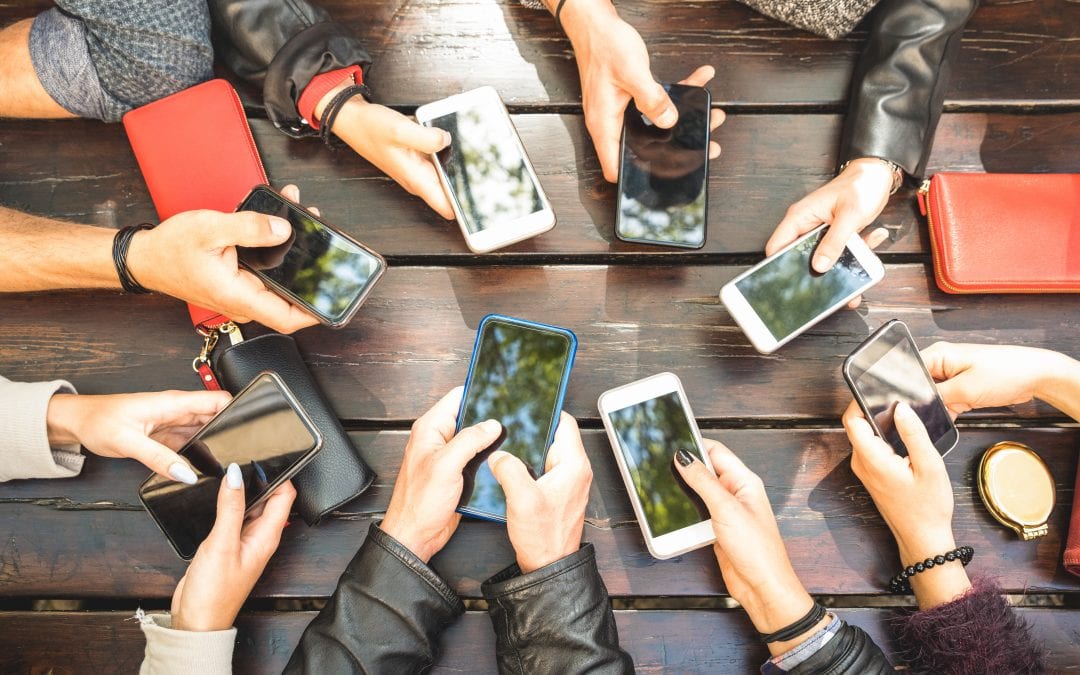Lorrie Hammerton, 2018
Do you wake up in the morning and check your smartphone as if it’s the morning newspaper? Do your fingers need to compulsively tap and swipe like a smoker needs to light a cigarette?
Smartphones have become a digital appendage. Always switched on, vibrating, beeping, flashing, and constantly demanding attention from an entity beyond our physical realm. Bjornsen and Archer (2015) claim these devices capitalise on our survival urge to belong by allowing an extension of “self” through social media. Instantly connected, all we need to do is reach into our pockets and chat, without uttering a single word. However, has instant connectivity fostered new addictive behaviours to satiate our primal need to belong?
Facebook, Twitter, and Instagram dominate social media (Bjornsen & Archer, 2015). In April 2016, Facebook boasted as being the most popular social networking site, with more than 1.5 billion active users. Approximately 75% of American teenagers and over 72% of American adults reported having an active Facebook account (Ehrenreich & Underwood, 2016). People emphasise their desirable traits by strategically curating their online public personas. Using stylised imagery, one can portray a carefree, happy, and social existence, possibly removed from offline reality.
Distracting us from mundane tasks, days are now peppered with actively hitting “Like” and “Follow” on personal pages, and passively scrolling through newsfeeds. With a few clicks, this virtual voyeurism offers instant rewards through validations by family, friends, and colleagues, appeasing the fear of missing out (Lister-Landman, Domoff, & Dubow, 2017). Nonetheless, while many connections are positive and satisfying, contemporary research suggests a dark side to virtual belonging.
Smartphones may encourage the constant and often frivolous use of social media which could develop addictive behaviours. Smahel, Brown, and Blinka (2012) reported that adolescents and young adults particularly used the virtual social world for identity formation. Just like junk food, their poor impulse control could not get enough of social media. At risk for Internet addiction, these individuals experienced mood changes, compulsive reward seeking, then gained tolerance, craved more contact, escaped offline problems, which created lower academic results. Greater numbers of social media check-ins reinforced stronger compulsive behaviour patterns (Smahel et al., 2012). The question arises as to why is social media so addictive.
Vogel, Rose, Roberts, and Eckles (2014) suggested that by virtually following friends, acquaintances, and celebrities, people might adversely judge and compare their lives to other seemingly utopian existences. This has led to a new way of satisfying the fundamental drive of social comparison. Upward social comparison was where one compared themselves to superiors with desirable characteristics, inspiring some to become more like their targets of admiration. However, it sometimes caused feelings of inadequacy and poor self-evaluation as certain goals were unattainable, and some offline interactions were impossible. Alternatively, an individual’s downward social comparison to those who were worse off could have led to improved self-evaluation, as their situation was more positive (Vogel et al., 2014). Which social comparison is adopted through social media may be dictated by individuals’ personality traits, thereby affecting compulsive habits.
A study by Lachman, Duke, Sariyska, and Montag (2017) revealed that people with low Self-Directedness were associated with high addictive use of both Internet and smartphone. Typically, such individuals were dissatisfied with their personalities, unable to achieve planned goals, and had lower willpower. To a lesser extent, those with high Neuroticism, (depression and loneliness), low Agreeableness (manipulative and uncooperative) and low Conscientiousness (antisocial) experienced similar obsessive behaviours. Generally, all these personality types often had low self-esteem and were vulnerable to adverse influences (Lachman et al., 2016). This vulnerability may have encouraged their negative social comparisons through compulsive social media connections.
Andreassen et al. (2016) confirmed this desire for social connectivity was the key reason for addictive Internet behaviour. This was particularly the case for those with Attention-Deficit/Hyperactivity Disorder (ADHD) and Obsessive-Compulsive Disorder (OCD). Such individuals were easily distracted by beeping and vibrating smartphones, which prompted constant social media checks. This reward system reinforced knowledge of what others were doing and satiated their fear of missing out.
Andreassen et al. (2016) also suggested that individuals suffering from anxiety had difficulties with real life communication, and preferred online interaction to overcome feelings of inadequacy. Additionally, compulsive use by younger females and single people was due to the proneness for social interaction and possibly meeting potential partners. However, what if an individual does not have an underlying mental disorder or susceptible personality trait and still adopts compulsive internet habits?
Ciarrochi, Jackson, Gloster, and Heaven (2016) found that addictive Internet use in seemingly normal adolescents was a prelude to declining mental health over time if left unchecked. Both male and female compulsive behaviour was associated with every form of internet use, except researching information. In fact, females engaged with more texting and Twitter, whereas males preferred gaming and adult-only sites. Growing up with technology at their fingertips, some used various applications as a feel good reward system. For some, this virtual conduit for expression and social comparison may lead to unhealthy identities and lower self-esteem during their formative years (Feinstein et al., 2016)
The evolving social media explosion is here to stay. The latest research confirms that the partial migration of our social lives from the physical to the World Wide Web has fostered connections unprecedented in the history of humankind (Crosier, Webster, & Dillon, 2012). Virtual connectivity can positively satisfy our social need to belong. Notwithstanding, certain personality types, those with mental health issues and young people, may be vulnerable to developing compulsive behaviours. For some, interactions can lead to poor mental wellbeing, isolation, unhealthy impulses, and reduced physical contact.
However, these individuals are not necessarily addicted to social media per se. Instead, they are addicted to each other to satiate their powerful instinct to belong (Underwood & Ehrenreich, 2017). The smartphone is merely a rewarding and convenient tool. Regardless, how do we help those who prefer to withdraw to a virtual world?
The challenge for us is to go on a balanced social media diet. Slowly quit the craving. Put out that Android. Turn off the iPhone before you develop an “iDisorder” (Bjornsen & Archer, 2015). Pick up that morning newspaper. Use fingers to turn the page. Dial the landline phone. Use your voice to communicate. Be physically present in the world. Be occasionally absent in the World Wide Web. Lead by example. Maybe then, the vulnerable members of society will detox and adopt an upward social comparison to like and follow you – offline.
References
Andreassen, C. S., Billieux, J., Griffiths, M. D., Kuss, D. J., Demetrovics, Z., Mazzoni, E., & Pallesen, S. (2016). The relationship between addictive use of social media and video games and symptoms of psychiatric disorders: A large-scale cross-sectional study. Psychology of Addictive Behaviors, 30(2), 252-262. http://dx.doi.org.ezproxy.une.edu.au/10.1037/adb0000160
Bjornsen, C. A., & Archer, K. J. (2015). Relations between college students’ cell phone use
during class and grades. Scholarship of Teaching and Learning in Psychology, 1(4), 326-336. http://dx.doi.org.ezproxy.une.edu.au/10.1037/stl0000045
Ciarrochi, J., Parker, P., Sahdra, B., Marshall, S., Jackson, C., Gloster, A. T., & Heaven, P. (2016). The development of compulsive Internet use and mental health: A four-year study of adolescence. Developmental Psychology, 52(2), 272-283. http://dx.doi.org.ezproxy.une.edu.au/10.1037/dev0000070
Crosier, B. S., Webster, G. D., & Dillon, H. M. (2012). Wired to connect: Evolutionary psychology and social networks. Review of General Psychology, 16(2), 230-239. http://dx.doi.org.ezproxy.une.edu.au/10.1037/a0027919
Ehrenreich, S. E., & Underwood, M. K. (2016). Adolescents’ internalizing symptoms as predictors of the content of their Facebook communication and responses received from peers. Translational Issues in Psychological Science, 2(3), 227-237. http://dx.doi.org.ezproxy.une.edu.au/10.1037/tps0000077
Feinstein, B. A., Hershenberg, R., Bhatia, V., Latack, J. A., Meuwly, N., & Davila, J. (2013). Negative social comparison on Facebook and depressive symptoms: Rumination as a mechanism. Psychology of Popular Media Culture, 2(3), 161-170. http://dx.doi.org.ezproxy.une.edu.au/10.1037/a0033111
Lachmann, B., Duke, É., Sariyska, R., & Montag, C. (2017). Who’s addicted to the smartphone and/or the Internet? Psychology of Popular Media Culture. Advance online publication. http://dx.doi.org.ezproxy.une.edu.au/10.1037/ppm0000172
Lister-Landman, K., Domoff, S. E., & Dubow, E. F. (2017). The role of compulsive texting in adolescents’ academic functioning. Psychology of Popular Media Culture, 6(4), 311-325. http://dx.doi.org.ezproxy.une.edu.au/10.1037/ppm0000100
Smahel, D., Brown, B. B., & Blinka, L. (2012). Associations between online friendship and Internet addiction among adolescents and emerging adults. Developmental Psychology, 48(2), 381-388. http://dx.doi.org.ezproxy.une.edu.au/10.1037/a0027025
Underwood, M. K., & Ehrenreich, S. E. (2017). The power and the pain of adolescents’ digital communication: Cyber victimization and the perils of lurking. American Psychologist, 72(2), 144-158. http://dx.doi.org.ezproxy.une.edu.au/10.1037/a0040429
Vogel, E. A., Rose, J. P., Roberts, L. R., & Eckles, K. (2014). Social comparison, social media, and self-esteem. Psychology of Popular Media Culture, 3(4), 206-222. http://dx.doi.org.ezproxy.une.edu.au/10.1037/ppm0000047



Recent Comments